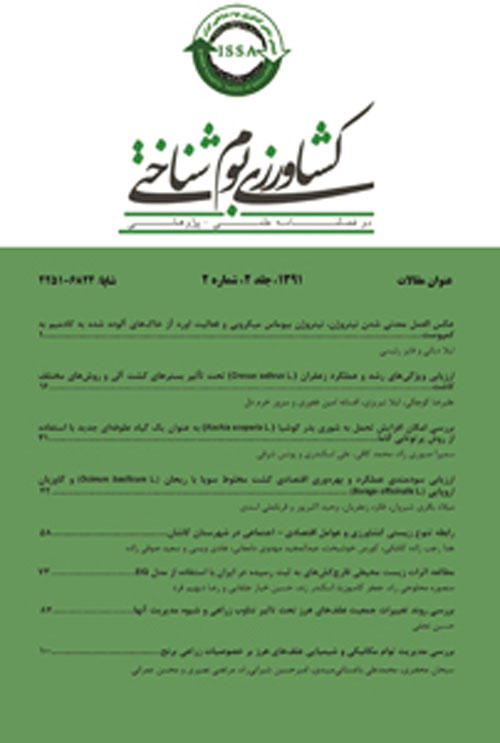Emergy evaluation of the performance and sustainability of three agricultural systems: Case of winter wheat, grain corn and spring forage corn in Dezful at Khozestan province, Iran
Author(s):
Abstract:
Introduction
In the present study, energy analysis was applied to compare and contrast resource use, environmental impact, and overall sustainability in three systems of grain corn (Zea mays L.), wheat, and forage corn at Dezful County in Khuzestan Province, Iran.Materials And Methods
As a top-down systems approach, the general methodology of energy evaluation consists of three steps: The first step in the application of the energy methodology is to construct system diagrams to identify all components and their relationships. The second step is to build the energy table, placing the numerical value and the units of each flow mentioned in the diagram; this table allows for the conversion of all the resources in terms of solar energy Joules using transformities (Odum, 1996). The third step is to obtain the energy indicators in order to evaluate the systems environmental performance. In many studies, energy related indices have been introduced to assess various aspects of the sustainability of a system (Chen et al., 2006; Odum, 1996). The main indices used to explore the sustainability of agriculture are the Energy Yield Ratio (EYR) and the Environmental Load Ratio (ELR); when combined in the Sustainability Index (SI), these give a general measure of ecological sustainability. For the collection of data for the use in the analyses, field experiments were set up and the data were collected from approximately 243 fields representing grain crops, spring forage corn and wheat in Dezful County of Khuzestan Province, Iran. The information collected includes data related to agricultural management techniques, socio-economic data that cover costs related to management techniques and the prices attainable for crops, crop yield, and details that describe the land areas within and outside the cropping area. Climatic data for this research has been obtained from the National Climate Centre. Energy unit values (or energy intensity values) were extrapolated from previous research (Ulgiati and Brown, 1998, Alipour et al., 2012).Results And Discussion
Results showed that energy yield ratios in winter wheat, grain corn and forage corn were 1.49E16, 1.57E16 and 1.59E16 Mj per hectare, respectively. The highest energy inputs in all systems were irrigation and fertilizers which were 86%, 87% and 82.8% of the total inputs of energy in wheat, forage corn and grain corn, respectively. An environmental loading ratio (ELR) was obtained for wheat, grain corn and forage corn of 0.49, 0.86 and 0.57, respectively and the energy sustainability index (ESI) was obtained for wheat, spring forage corn and grain corn at 4.99, 4.12 and 2.06, respectively. Results indicated that wheat production is the most sustainable system in terms of energy indices because it has the lowest environmental loading and highest environmental health. Results showed that the sustainability of these systems is acceptable because of higher share of irrigation in their energy flow.Conclusion
According to several energy indices, of the three systems evaluated the wheat system had the greatest level of sustainability. A sensitivity analysis showed that the energy inputs of irrigation water and fertilizer were the highest sensitivity factors influencing the energy ratios. Best management practices, alongside other agro-ecological strategies, could be implemented to make further improvements in the sustainability of the three systems. In this regard, Integrated Plant Nutrient Management (IPNM) (such as manure, compost, artificial enrichment with CO2, genetic selection or inhibition of photo respiration and night respiration) can either improve the nutrient balance or minimize the negative impact of the fertilizers, playing an important role in all levels of agro-ecosystem.Keywords:
Language:
Persian
Published:
Journal of Agroecology, Volume:6 Issue: 2, 2017
Page:
139
magiran.com/p1681004
دانلود و مطالعه متن این مقاله با یکی از روشهای زیر امکان پذیر است:
اشتراک شخصی
با عضویت و پرداخت آنلاین حق اشتراک یکساله به مبلغ 1,390,000ريال میتوانید 70 عنوان مطلب دانلود کنید!
اشتراک سازمانی
به کتابخانه دانشگاه یا محل کار خود پیشنهاد کنید تا اشتراک سازمانی این پایگاه را برای دسترسی نامحدود همه کاربران به متن مطالب تهیه نمایند!
توجه!
- حق عضویت دریافتی صرف حمایت از نشریات عضو و نگهداری، تکمیل و توسعه مگیران میشود.
- پرداخت حق اشتراک و دانلود مقالات اجازه بازنشر آن در سایر رسانههای چاپی و دیجیتال را به کاربر نمیدهد.
In order to view content subscription is required
Personal subscription
Subscribe magiran.com for 70 € euros via PayPal and download 70 articles during a year.
Organization subscription
Please contact us to subscribe your university or library for unlimited access!


